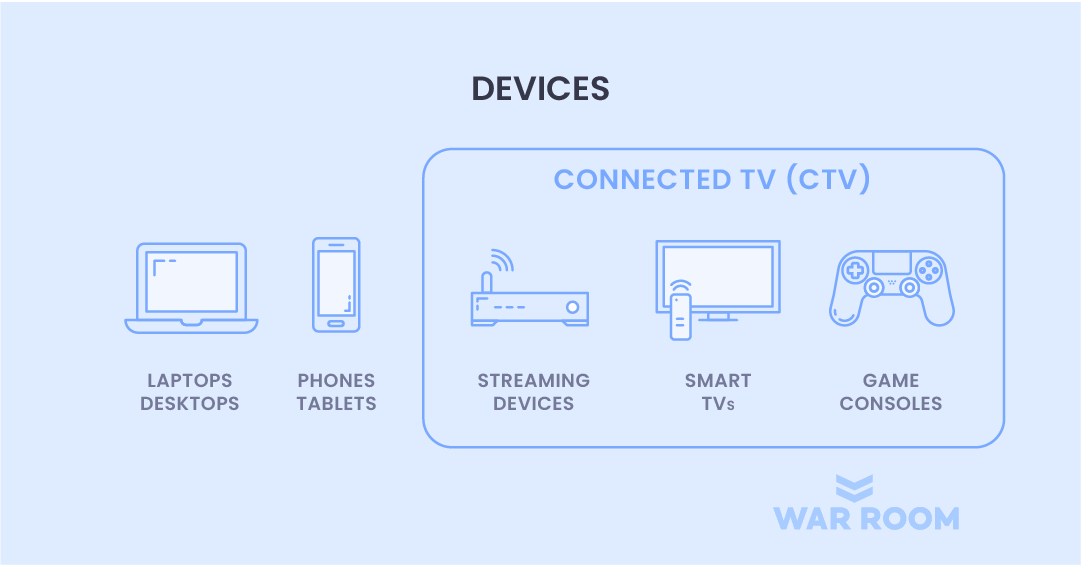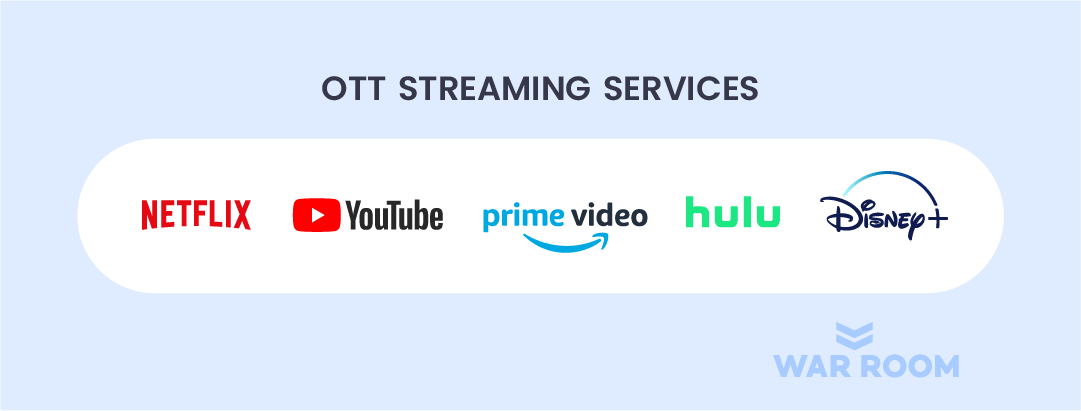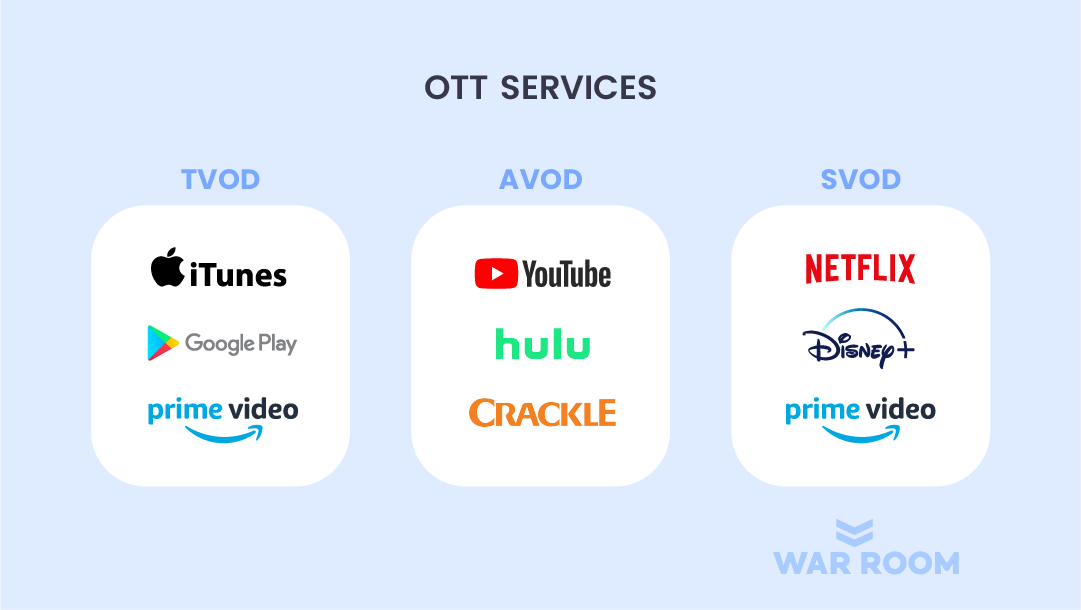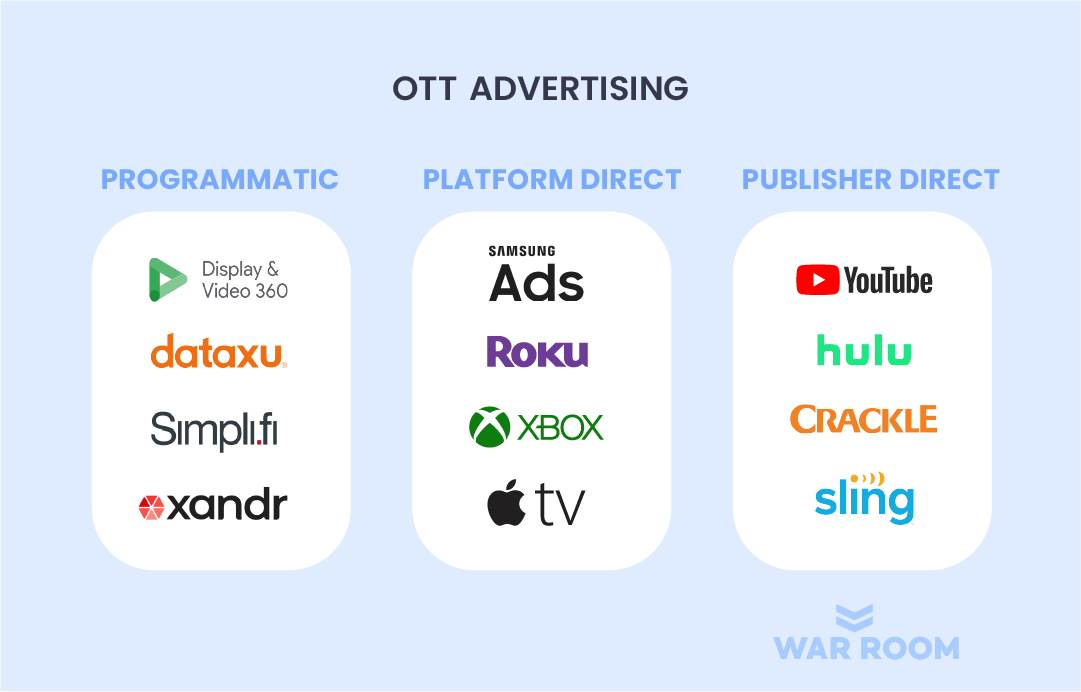Over-The-Top (OTT) has been quickly gaining momentum in the video streaming and advertising world. Let’s go over what it is all about.
Here is the outline we will be covering in this blog:
What is OTT (Over The Top)?
Streaming platforms are all the rage nowadays, with Netflix, Amazon Prime, Disney+, Apple TV, etc. all fighting for people’s attention. What do they have in common? These channels are all OTT (Over The Top), meaning video content delivered over the internet, versus traditional satellite or cable TV.
An important term associated with OTT is Connected TV (CTV).
Connected TV stands for the device one uses to watch OTT video. Note, it is closely related but not the same.
OTT is the actual delivery method, which is bypassing satellite and cable TV, hence, going over “the top”.
As consumer demand for delivering content over the top grows, the demand for opportunities like an OTT advertiser or all-in-one OTT platform provider rises as well. This allows to manage and deliver seamless, high-quality content to their audiences. With OTT, companies can reach users wherever they are, on any internet-connected device, without the limitations of traditional TV infrastructure.
OTT ads are served through video format on:
- Smart TV apps (like Netflix, HBO Go)
- Streaming boxes (Apple TV etc.)
- HDMI sticks (Amazon Firestick, Roku, Chromecast)
Amazon’s Fire TV has 50 million active accounts and Roku has 46 million.
Here is a quick breakdown of OTT devices. Note that Connected TV devices are a subset under OTT.

Growth of OTT
The COVID-19 pandemic in 2020 sped things up for the popularity of OTT channels. People are spending more time at home, and all streaming channels have seen a jump in subscriptions. Many are switching from cable television to only streaming (cutting the “cord” if you will).
Emarketer predicts that the number of US households that subscribe to traditional television will drop from 86.5 million to 72.7 million between 2019 and 2023.
As mentioned earlier, OTT is streamed through Connected TV (CTV).
Here are some statistics to showcase how popular streaming channels are:
- 61% of US households subscribe to 2+ OTT channels
- 45% subscribe to 3+ OTT channels
- 31% subscribe to 4 or more
- Netflix
- Disney+
- Amazon Prime Video
- Apple TV+

To give you a sense of how big the userbases are, as of December 2020:
It’s the hottest thing, and everyone wants a piece. Players that recently entered the arena include:
- Hulu
- HBO Max (HBO)
- Peacock (NBC)
- Discovery+
- AMC+ (AMC)
- Shutter
- Crunchyroll and more
Some showcased their entire media library, others like Shutter and Crunchyroll focus on niches: horror and anime–to cater to specific audiences.
This competitive group is often dubbed as “The Streaming Wars”. Here is a 2019 CNBC feature and a quick look at their analysis in 2021:
The public loves being able to watch Videos On Demand (VOD), binge an entire TV series with no commercial breaks, any time of the day.
How do brands manage to reach people in their households in this new era of media consumption?
What is OTT Advertising?
Now that you have a better understanding of OTT, let’s dive into the advertising side of it!
There are three primary types of OTT services:
- Transactional Video-On-Demand (TVOD): pay-per-view
- Advertising-based Video-On-Demand (AVOD): content is free, but with ads
- Subscription Video-On-Demand (SVOD): ad-free paid content

There are three ways to buy and deliver OTT ads:
- Programmatic OTT ads: served across multiple networks through Demand Side Platforms (DSPs) using automation
- Platform Direct ads: purchased from the OTT device provider
- Publisher Direct ads: purchased through the OTT service provider

Across these channels, ad formats may include:
- Banner ads
- Sponsored content
- In-stream video ads
OTT can be streamed across different devices aside from TV, such as mobile phone, computer or gaming consoles like Playstation. This expands audience reach options. Because it’s internet-based, ads can be delivered to anyone around the world who has access to OTT TV. Pretty neat, right? Why don’t we now look at some benefits of this method of advertising?
Benefits of OTT Advertising
Guaranteed Ad Delivery
What makes OTT ads effective is that they viewers can’t skip an ad or close a window nor use ad blocker. The viewer may not be able to click through to your website via TV, but video completion rates are very high instead. So make sure your ads are visually-grabbing and make an impression!
More Accessible & Affordable Than Traditional TV Ads
The number of people using Connected TV to stream video content is increasing. Why not take advantage of this trend and show off your brand on a whole new platform? OTT has made advertising to audiences in their households accessible to brands. Bypass lengthy negotiations for a TV spot with a specific channel on a particular day and time within a certain region. Ads can be served to the right people at the right time directly.
Granular Audience Targeting
Compared to traditional television advertising, OTT has the capability of hyper-targeting audiences. You won’t be limited to regional TV stations anymore, think big and think global. Advertisers can leverage consumer data such as online browser and purchase history to set up their audience segment.
Excellent for Retargeting
OTT enables advertisers to retarget users who have seen their ads elsewhere. It closes the cross-channel loop, which is invaluable for advertisers. It can be easily incorporated into a bigger marketing strategy and capture audiences.
Ad Performance Attribution
For every marketer, Return on Ad Spend (ROAS) is an important metric to measure. Because OTT is internet-based, it has detailed data analytics of ad performance, which allows brands to attribute that to conversions (website visit, sale etc.). Insights gained from finding out which ads were effective and which weren’t are useful for optimizing future ads!
OTT is booming and only going to continue to grow.
As a programmatic advertising agency specializing in hyper-targeting audiences for our clients, we cannot stress enough how much potential OTT advertising can have.
We think it is an excellent channel for brands to consider branching out to. It can amplify your ads on other ad channels such as Display and Social campaigns.

What Have We Learned?
OTT stands for Over-The-Top. It encompasses the streaming of video content over the internet, versus traditional TV, which is delivered via satellite or cable channels.
Connected TV (CTV) stands for the device OTT is delivered through, which might be HDMI sticks, streaming boxes, or Smart TVs.
Millions of households subscribe to 2 or more streaming channels. Many are even saying goodbye to cable TV and going streaming only. COVID-19 has sped up this process, and OTT is continuously gaining momentum.
OTT Advertising has many benefits as it is internet-based, which offers flexibility over traditional TV advertising. These benefits may include:
- Ads can’t be skipped, which guarantees eyes on ads
- Bypassing the complex process of buying TV spots on cable networks
- Hyper-targeting audience segments
- Retargeting capabilities to close the cross-channel loop and capture conversions
- Proper ad attribution and ROAS calculation
To leverage the full potential of OTT advertising, partnering with a provider of OTT platform development services can ensure a customized, efficient, and scalable solution tailored to your brand’s specific needs and objectives.
We think OTT has great potential and is a great advertising channel to consider to expand your marketing strategy.











